Martinndungu1986
On this page, you find all documents, package deals, and flashcards offered by seller martinndungu1986.
- 630
- 0
- 20
Community
- Followers
- Following
650 items
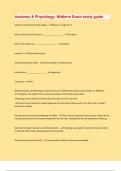
Anatomy & Physiology- Midterm Exam study guide|questions and accurate answers
Anterior and Posterior body regions - figure 1.5 page 16-17 bone at the back of the head =___________________ - occipital bone of the upper lip = ___________________ - maxilla canaliculi - little blood vessels central (Haversian) canals - Runs vertically in compact bone cheek bone = _________________ - zygomatic Cutaneous - skin Define Anatomy and Physiology. Tell how they are related terms and how the studies are different. - -Anatomy: the study of the structure and shape of the body an...
- Exam (elaborations)
- • 13 pages •
Anterior and Posterior body regions - figure 1.5 page 16-17 bone at the back of the head =___________________ - occipital bone of the upper lip = ___________________ - maxilla canaliculi - little blood vessels central (Haversian) canals - Runs vertically in compact bone cheek bone = _________________ - zygomatic Cutaneous - skin Define Anatomy and Physiology. Tell how they are related terms and how the studies are different. - -Anatomy: the study of the structure and shape of the body an...
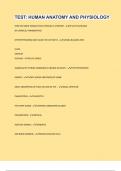
TEST: HUMAN ANATOMY AND PHYSIOLOGY QUESTIONS AND ACCURATE ANSWERSS
HOW DO NERVE SIGNALS PASS THROUGH A SYNAPSE? - BY ACETYLCHOLINE BY CHEMICAL TRANSMITTERS HYPERTHYROIDISM MAY CAUSE THE VICTIM TO - HAVING BULGING EYES ILIUM SACRUM ISCHIUM - PELVIC GIRDLE INADEQUATE THYROID HORMONE IS KNOWN AS WHAT? - HYPOTHYROIDISM KIDNEYS - PURIFY BLOOD AND PRODUCE URINE MOST ABSORPTION OF FOOD OCCURS IN THE : - SMALL INTESTINE PHAGOCTOSIS - LEUKOCTES PITUITARY GLAND - CONTROLS ENDOCRINE GLANDS POLARIZATION - IMPULSE RECEIVES SIGNALS - DENDRITE RED BONE MARROW - P...
- Exam (elaborations)
- • 4 pages •
HOW DO NERVE SIGNALS PASS THROUGH A SYNAPSE? - BY ACETYLCHOLINE BY CHEMICAL TRANSMITTERS HYPERTHYROIDISM MAY CAUSE THE VICTIM TO - HAVING BULGING EYES ILIUM SACRUM ISCHIUM - PELVIC GIRDLE INADEQUATE THYROID HORMONE IS KNOWN AS WHAT? - HYPOTHYROIDISM KIDNEYS - PURIFY BLOOD AND PRODUCE URINE MOST ABSORPTION OF FOOD OCCURS IN THE : - SMALL INTESTINE PHAGOCTOSIS - LEUKOCTES PITUITARY GLAND - CONTROLS ENDOCRINE GLANDS POLARIZATION - IMPULSE RECEIVES SIGNALS - DENDRITE RED BONE MARROW - P...

Test 1 Anatomy & Physiology - Chapters 1-4 questions and verified answers
polymers defintion - made up of monomers, joined together by a process called dehydration synthesis polysaccharides - polymers of simple sugars linked together by dehydration synthesis positive feedback mechanism - result or response enhances the original stimulus so that the response is accelerated. moves in the same direction as the initial change. usually control infrequent events that do not require continuous adjustments. +feedback mechanisms are often referred to as cascades. exampl...
- Exam (elaborations)
- • 10 pages •
polymers defintion - made up of monomers, joined together by a process called dehydration synthesis polysaccharides - polymers of simple sugars linked together by dehydration synthesis positive feedback mechanism - result or response enhances the original stimulus so that the response is accelerated. moves in the same direction as the initial change. usually control infrequent events that do not require continuous adjustments. +feedback mechanisms are often referred to as cascades. exampl...
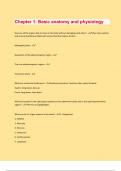
Chapter 1: Basic anatomy and physiology questions with well researched answers
How are all the organs able to move in the body without damaging each other? - They have parietal and visceral membranes filled with serous fluid that reduce friction Midsagittal plane - Quadrants of the abdominopelvic region - The nine abdominopelvic regions - Transverse plane - What are anatomical landmarks? - Anatomical position: hands at sides, palms forward Supine: lying down, face up Prone: lying down, face down What are located in the right upper quadrant in the abdominal cav...
- Exam (elaborations)
- • 5 pages •
How are all the organs able to move in the body without damaging each other? - They have parietal and visceral membranes filled with serous fluid that reduce friction Midsagittal plane - Quadrants of the abdominopelvic region - The nine abdominopelvic regions - Transverse plane - What are anatomical landmarks? - Anatomical position: hands at sides, palms forward Supine: lying down, face up Prone: lying down, face down What are located in the right upper quadrant in the abdominal cav...

Anatomy and Physiology- Chapter 1 questions with 100% correct answers
Abdominopelvic Regions - Umbilical, Epigastric, Hypograstic, Iliac (right/left), Lumbar (right/left), Hypochondriac Anatomical Position - Body facing forward; Palms facing out; thumbs pointing away from body Anatomy - study of the structure of body parts and their relationships to one another Anterior - towards or at the front of the body; in front of Body Planes and Sections - Cellular Anatomy - considers the cells of the body Circulatory System ( Cardiovascular System) - blood vessels ...
- Exam (elaborations)
- • 6 pages •
Abdominopelvic Regions - Umbilical, Epigastric, Hypograstic, Iliac (right/left), Lumbar (right/left), Hypochondriac Anatomical Position - Body facing forward; Palms facing out; thumbs pointing away from body Anatomy - study of the structure of body parts and their relationships to one another Anterior - towards or at the front of the body; in front of Body Planes and Sections - Cellular Anatomy - considers the cells of the body Circulatory System ( Cardiovascular System) - blood vessels ...
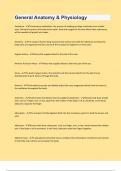
General Anatomy & Physiology questions with accurate and verified answers
Anabolism - Constructive metabolism, the process of building up larger molecules from smaller ones. During this process the body stores water, food and oxygen for the time when these substances will be needed cell growth and repair. Anatomy - The study of human body structure that can be seen with the naked eye and how the body parts are organized and the science of the structure of organisms or their parts. Angular Artery - Artery that supplies blood to the side of the nose. Anterior Auri...
- Exam (elaborations)
- • 24 pages •
Anabolism - Constructive metabolism, the process of building up larger molecules from smaller ones. During this process the body stores water, food and oxygen for the time when these substances will be needed cell growth and repair. Anatomy - The study of human body structure that can be seen with the naked eye and how the body parts are organized and the science of the structure of organisms or their parts. Angular Artery - Artery that supplies blood to the side of the nose. Anterior Auri...
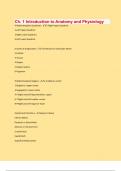
Ch. 1 Introduction to Anatomy and Physiology questions and correct answers verified and graded A++
4 Abdominopelvic Quadrants - 1-Right Upper Quadrant 2-Left Upper Quadrant 3-Right Lower Quadrant 4-Left Lower Quadrant 6 Levels of Oragnization - 1-Chemical (or molecular) Atoms 2-Cellular 3-Tissues 4-Organs 5-Organs System 6-Organism 9 Abdominopelvic Regions - 1-Umbilical--center 2-Epigastric--upper center 3-Hypogastric--lower center 4-5 Right and Left Hypochondriac--upper 6-7 Right and Left Lumbar--center 8-9 Right and Left Inguinal--lower Anatomical Directions - Superior-Above...
- Exam (elaborations)
- • 6 pages •
4 Abdominopelvic Quadrants - 1-Right Upper Quadrant 2-Left Upper Quadrant 3-Right Lower Quadrant 4-Left Lower Quadrant 6 Levels of Oragnization - 1-Chemical (or molecular) Atoms 2-Cellular 3-Tissues 4-Organs 5-Organs System 6-Organism 9 Abdominopelvic Regions - 1-Umbilical--center 2-Epigastric--upper center 3-Hypogastric--lower center 4-5 Right and Left Hypochondriac--upper 6-7 Right and Left Lumbar--center 8-9 Right and Left Inguinal--lower Anatomical Directions - Superior-Above...
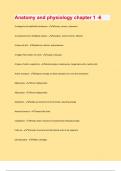
Anatomy and physiology chapter 1 -6 questions and verified answers
3 categories of epithelial membrane - Mucous, serous, cutaneous 3 components of a feedback system - Receptor, control center, effector 3 layers of skin - Epidermis, dermis, subcutaneous 3 stages that matter can exist - Liquid, solid, gas 4 types of cells in epidermis - Keratinocytes, melanocytes, langerhans cells, merkel cells Active transport - Requires energy to allow substance to cross the membrane Adipocytes - Stores triglycerides Adipocytes - Stores triglycerides Anabolism - Builds ...
- Exam (elaborations)
- • 7 pages •
3 categories of epithelial membrane - Mucous, serous, cutaneous 3 components of a feedback system - Receptor, control center, effector 3 layers of skin - Epidermis, dermis, subcutaneous 3 stages that matter can exist - Liquid, solid, gas 4 types of cells in epidermis - Keratinocytes, melanocytes, langerhans cells, merkel cells Active transport - Requires energy to allow substance to cross the membrane Adipocytes - Stores triglycerides Adipocytes - Stores triglycerides Anabolism - Builds ...
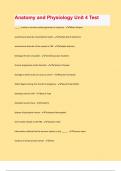
Anatomy and Physiology Unit 4 Test Qquestions and answers
_____ is when a nervous system generates a response. - Motor Output autoimmune disorder of peripheral myelin - Guillain-Barré Syndrome autoimmune disorder of the myelin in CNS - Multiple Sclerosis blockage of brain circulation - Cerebrovascular Accident chronic progressive motor disorder - Parkinson's Disease Damage to which area can cause a coma? - Reticular Formation defect begins during first month of pregnancy - Neural Tube Defect develops into the CNS - Neural Tube develops neural...
- Exam (elaborations)
- • 3 pages •
_____ is when a nervous system generates a response. - Motor Output autoimmune disorder of peripheral myelin - Guillain-Barré Syndrome autoimmune disorder of the myelin in CNS - Multiple Sclerosis blockage of brain circulation - Cerebrovascular Accident chronic progressive motor disorder - Parkinson's Disease Damage to which area can cause a coma? - Reticular Formation defect begins during first month of pregnancy - Neural Tube Defect develops into the CNS - Neural Tube develops neural...
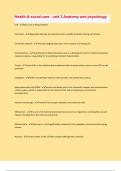
Health & social care - unit 3 Anatomy and physiology questions and correct answers graded A+
Cell - Basic unit of living material Centrioles - Organelles that play an important part in spindle formation during cell division. Chromatin network - The dark tangled mass seen in the nucleus of a resting cell. Chromosomes - Long threads of DNA and protein seen in a dividing cell, which contains the genetic material or genes, responsible for transmitting inherited characteristics. Cristea - Inner folds in the mitochondria membrane that increases surface area so more ATP can be produced ...
- Exam (elaborations)
- • 2 pages •
Cell - Basic unit of living material Centrioles - Organelles that play an important part in spindle formation during cell division. Chromatin network - The dark tangled mass seen in the nucleus of a resting cell. Chromosomes - Long threads of DNA and protein seen in a dividing cell, which contains the genetic material or genes, responsible for transmitting inherited characteristics. Cristea - Inner folds in the mitochondria membrane that increases surface area so more ATP can be produced ...
